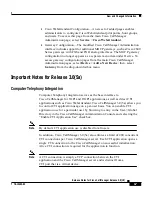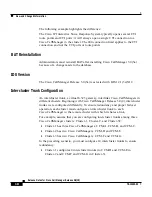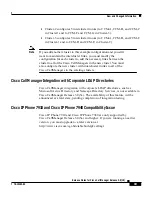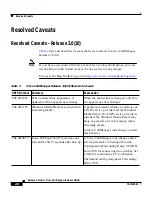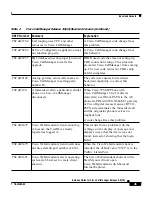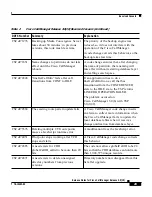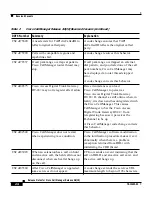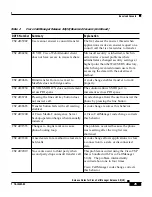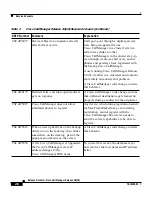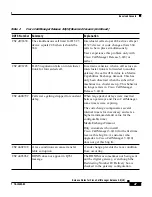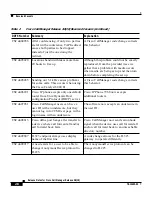
13
Release Notes for Cisco CallManager Release 3.0(10)
78-13493-02
New and Changed Information
•
Simpler configuration—Previous versions of Cisco CallManager required all
Cisco CallManagers in separate clusters to be configured in the Cisco MCM
as a source address/destination address (SA/DA) pair. Registration by cluster
pairs meant that for a ten-site system, 90 (9 x 10) separate entries would be
required in the Cisco MCM configuration. Also, because the SA/DA name
required a hexadecimal address, configuration at the Cisco MCM and in the
Cisco CallManager database was error prone. Cisco CallManager Release
3.0(5a) allows individual gatekeeper-controlled Cisco CallManagers to be
configured at the Cisco MCM and allows a Cisco CallManager host name or
dotted decimal IP address to be used instead of a hexadecimal address.
•
More efficient Cisco CallManager to H.323 Gatekeeper
registration—Cisco CallManager can register to the Cisco MCM using full
RRQ upon Cisco CallManager initialization. Subsequent RRQs are
periodically sent to the gatekeeper as a keep-alive function. In
Cisco CallManager Release 3.0(5a) the lightweight RRQ format of H.225
RAS specification is used to reduce periodic-processing burden on the
Cisco MCM CPU.
•
Admission Request (ARQ) enhancements—When an intercluster call is
initiated, the gatekeeper-controlled Cisco CallManager in a cluster issues the
E.164 address of the destination in its ARQ to the MCM. Also, the
gatekeeper-controlled Cisco CallManager in the source cluster accepts the IP
address of the destination device in the resulting Admission Confirm (ACF)
message.
•
Gatekeeper-controlled Cisco CallManagers, during the initial RRQ, send a
full E.164 address range Cisco MCM—Cisco MCM will accept the
registration now that it is aware of the full E.164 address range of the cluster
associated with that gatekeeper-controlled Cisco CallManager. Future
enhancements to the Cisco MCM software will include the ability for
Cisco MCM to automatically add the address ranges to the Cisco MCM dial
plan.
Cisco IP Phone Services on Cisco Pixel-Based Display Phones
Cisco IP Phone 7940 and Cisco IP Phone 7960 have an HTTP client with an XML
parser. When a user presses the Services fixed-function button, the HTTP client
will attach to a preconfigured (by the administrator) URL. This URL will display
a menu of available HTML/XML services for the user. These services are
normally located on an HTTP server separate from the Cisco CallManager or

















